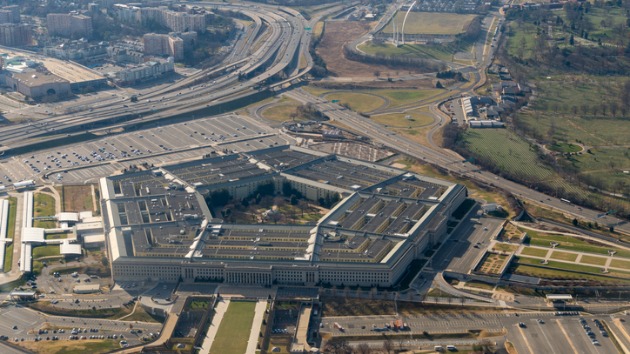
(WASHINGTON) — China is rapidly increasing the size of its nuclear arsenal and could have as many as 1,000 nuclear warheads by 2030, according to a new Pentagon report released Wednesday.
The development comes on the heels of China’s recent test of a hypersonic weapon that has raised serious concerns about China’s military buildup and its growing capability.
“The accelerating pace of the PRC’s nuclear expansion may enable the PRC (People’s Republic of China) to have up to 700 deliverable nuclear warheads by 2027,” said this year’s version of the annual Pentagon report formally known as “Military and Security Developments Involving the People’s Republic of China.”
“The PRC likely intends to have at least 1,000 warheads by 2030, exceeding the pace and size the DoD projected in 2020,” it added. That increase is dramatically different than was projected in last year’s version of the report which predicted a doubling of China’s current nuclear arsenal of several hundred warheads.
Even with China’s dramatic increase, it’s larger nuclear arsenal will still be much less than the United States’ declared stockpile of 3,750 warheads capable of being deployed by hundreds of land-based and sea-launched missiles and a strategic bomber fleet.
In recent months, the growth of China’s nuclear force has been captured by commercial satellite images showing the construction of hundreds of missile silos at three locations in northern and western China.
“New developments in 2020 further suggest that the PRC intends to increase the peacetime readiness of its nuclear forces by moving to a launch-on-warning (LOW) posture with an expanded silo-based force,” said the report.
China’s leaders have publicly stated that they want China’s military become a global power by 2050 as they move beyond what is currently assessed to be a military force with only regional capabilities.
The report indicated China’s growth of its military capabilities are in line with that plan noting that they “continue to strengthen the PRC’s ability to “fight and win wars” against a “strong enemy” [a likely euphemism for the United States], coerce Taiwan and rival claimants in territorial disputes, counter an intervention by a third party in a conflict along the PRC’s periphery, and project power globally.”
That growing military capability was demonstrated recently after reports emerged that over the summer China had tested a new hypersonic glide weapon capable of orbiting the earth that could eventually carry a nuclear weapon.
The development of a “fractional orbital bombardment system” raised concerns about how the United States could counter such a system that could conceivably travel at hypersonic speeds, or greater than five times the speed of sound, after reentering the atmosphere.
Like other hypersonic vehicles it would be hard to track because the glide vehicles are maneuverable in the atmosphere, unlike ballistic warheads that follow a fixed trajectory, meaning they could weave their way around American radars and ground-based interceptor missile systems.
“The U.S. does not currently have the ability to even track this weapon, much less defeat it,” said Steve Ganyard, a retired Marine colonel and ABC News contributor who noted that American radars pointing to the Cold War threat of missiles coming over the North Pole would not be in a position to detect a hypersonic weapon coming from the south.
Earlier on Wednesday, Gen. Mark Milley, the chairman of the Joint Chiefs of Staff, acknowledged that China’s recent test of an apparent hypersonic weapon capable of delivering a nuclear warhead was “very significant,” but “not a Sputnik moment,” at least in terms of novelty.
That term refers to the 1957 launch of the Sputnik satellite by the Soviet Union that caught Americans off guard and led the United States to play catch up leading to a space and arms race.
“They’re not new, they’ve been around for a while. So, in that limited, narrow sense, it’s not a Sputnik moment, because Sputnik was new at the time,” Milley said in comments at the Aspen Security Forum in Washington, D.C.
Last week, Milley was the first American official to publicly confirm the test labeling it “a very significant technological event” but also said he didn’t know “if it’s quite a Sputnik moment, but I think it’s very close to that.”
Milley described the test as part of the larger trend by China to be a bigger player on the international stage.
“If you look at the totality, this test that occurred a couple weeks ago is only one of a much, much broader picture of a military capability with respect to the Chinese,” said Milley. “That is very, very significant. We’re witnessing, in my view, we’re witnessing one of the largest shifts in global geostrategic power at the world has witnessed.”
Recent flight activity near Taiwan has once again raised concerns about whether China is poising to launch military action against the island it considers to be a breakaway province.
Asked if he believed that China is likely to invade Taiwan, Milley replied, “Based on my analysis of China, I don’t think that is likely in the next near future,” a time period he defined as meaning over the next six to 24 months.
“Having said that, though, the Chinese are clearly and unambiguously building the capability to provide those options to the national leadership if they so choose at some point in the future,” he said.
Copyright © 2021, ABC Audio. All rights reserved.
